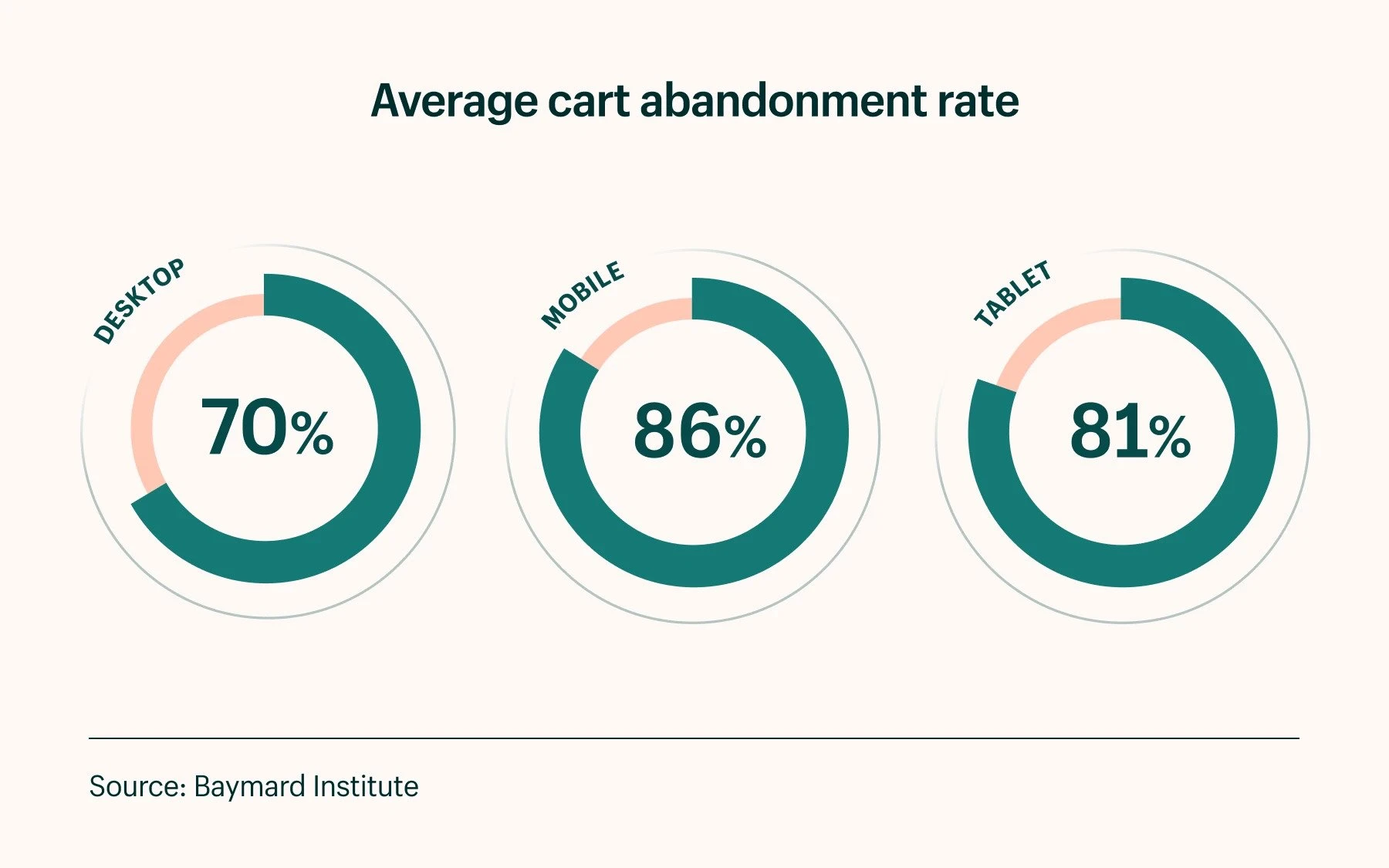How do you know whether or not your eCommerce store is performing the way you want it to? Do you rely on gut instinct to guide you or maybe something a little more advanced? The good news is that you can track your site's performance in a scientific and measurable way using KPIs or key performance indicators.
Once you’ve created your online store, think of KPIs as the rowers steering your boat towards your success. Your business goals are the final destination, but you won't get there if rowers are out of sync. Your KPIs should be front and center in your business because they will give you a good indication of how healthy your business is and how likely you are to hit your targets.
You don't need to be a math wiz or data scientist to do these calculations either - we'll guide you through them step-by-step.
What are eCommerce KPIs?
Key performance indicators are metrics used to measure the success of everyday business activities against your eCommerce goals. Think of these numbers as the measurements that show whether or not you are progressing towards your larger goals. For example, you may have a goal to increase sales by 25% by the end of the year. Your KPIs are the activities that will help you reach that goal, e.g., "increasing the number of unique visitors by 15%" or "increasing average cart size by 10%".
Top eCommerce KPIs
So, which KPIs should you track for your business? There is no hard and fast rule, but experts recommend that you focus on about five top indicators based on your unique business profile. You might want to recoup the money you've invested in your business, increase your profit margins to focus on your side business full-time or expand into new product lines or territories. Your KPIs should be based on where you are going and reflect how you will get there.
Let's look at the three main KPIs your eCommerce business should track:
Average Order Value
The Average Order Value or AOV measures how much customers spend in your store every time they order. You can calculate this by dividing your total sales by the number of transactions, like this:
Total Sales/Number of Transactions = Average Order Value
This helps you understand your customers better and facilitate your special offers and marketing campaigns. For example, if your average order value is $50, you could potentially increase your order size by offering free shipping for all orders over $75.

Customer Lifetime Value
Customer Lifetime Value (CLV) measures how much your eCommerce store can earn from the average customer throughout the relationship. Loyal customers are more likely to make repeat purchases and recommendations and spend a lot more over time than customers who only make large one-off purchases.
For example, Customer A spends $1000 buying a big-ticket item on your site but never comes back again. Customer B spends an average of $15 at a time when they visit twice a month. You may think you should focus your efforts on convincing Customer A to return to your site, but you should actually spend your marketing budget retaining Customer B.
The CLV calculation reveals:
Average Transaction Size x Number of Annual Transactions x Retention Period = Customer Lifetime Value
$15 (average transaction size) x 24 (number of annual visits) x 5 years (number of years active) = $1800
Try to boost the lifetime value of customers through loyalty programs and special offers. Retention is often more financially rewarding (and less expensive) than pursuing new customers.
Sales Conversion Rate
Your sales conversion rate shows how successful your eCommerce shop is at converting visitors to actual paying customers. Of course, this reveals a lot in and of itself!
Your sales conversion rate shows that your SEO and ad campaigns target the right customers, that your customers are finding what they are looking for, and that your UX is driving customers towards making a purchase…or not. Your sales conversion rate is calculated like this:
Number of Sales/Number of Visits = Sales Conversion Rate %
Don't worry if this number feels really low - the average conversion rate for US eCommerce stores is around 2.86%. Always research your eCommerce benchmarks to ensure that your targets are realistic and in line with the industry average.

Best KPIs For Measuring the Performance of an eCommerce Business
Now that we've looked at the top three most-used KPIs in eCommerce businesses, we can look at a few others you might want to consider. As we've mentioned, the best KPIs for measuring the performance of an eCommerce business can vary from company to company, according to your goals, so consider each option in the context of your own website.
Your Overall Sales
Your overall sales figure is one of the most important eCommerce KPIs and metrics to track. Unlike some of the other metrics we've looked at, there's no need for manual calculation here. Your eCommerce platform or plugin should have sales and revenue tracking capabilities that can be accessed via its dashboard. We recommend adding Google Analytics to your site to access even richer data.
If you are already using basic page tracking, you'll just need to add JavaScript to your site and shopping cart software to send transaction and product data to Google Analytics. Once you've set up your site, you can easily track your eCommerce results. Try to check in on your overall sales on a daily, weekly, monthly, quarterly, and annual basis. You may be able to spot important seasonal trends and data that you can use in the future to increase your overall sales figures.
Monthly Traffic Growth Rate
Anyone with a website needs to track traffic growth - the more traffic you have, the greater the number of potential customers you can acquire. This KPI also indicates how well your paid ads and SEO is performing.
You can easily track your monthly growth rate using this formula:
(Number of Sessions from Current Month - Number of Sessions from Previous Month) / Sessions from Previous Month x 100 = % Monthly Growth Rate
You can also use this formula to calculate your annual traffic by simply using your yearly figures instead of monthly figures.
Time Spent on Site
Time spent on site is the average amount of time your visitors spend browsing your site and scrolling through your content before they leave. This metric is important because it speaks to the relevance of your site to the visitors you are targeting. If a customer lands on your site and immediately clicks away, chances are they are not the customers you want to spend your marketing dollars on. You can find the time spent on-site in Google Analytics (called the Average Session Duration metric) or calculate it manually:
Time Spent on Site by Users/(Page Views - Page Exits) = Average Time Spent on Site
The average time spent on a site is just under a minute (54 seconds), according to Hubspot, but for highly engaging sites like Amazon, sessions can last as long as ten minutes. The best way to increase time spent on site is to optimize your site speed and layout - slow, cluttered pages will lead to high bounce rates. Helpful tip: you might want to check out a few ways to optimize your user experience if your average time spent on site is lower than your industry benchmarks.
Return on Ad Spend
Is your advertising bringing the results you want? You can measure how effective your marketing efforts are by calculating how much revenue you've earned for every dollar you've spent on advertising:
Campaign Revenue/Cost of Campaign = Return on Ad Spend
Again, what is considered a "good" return on ad spend will vary from business to business, but in general, you should aim for a return on ad spend of around 3:1, meaning that you earn $3 in revenue for every dollar you spend. The higher your Return on Ad Spend ratio, the more effective your ads are at bringing in high-paying clients. A weak ratio usually indicates that you need to tweak your advertising or reduce your spending.
Cart Abandonment Rate
Cart abandonment occurs when visitors add items to their basket or cart and leave without completing the purchase. Cart abandonment rates are usually quite high.
(77.13 percent, depending on your industry) but you should try to reduce this as much as possible.
Most cart abandonment rates are calculated automatically by your eCommerce tools, but you can calculate your rate manually as well:
(Completed Purchases/Shopping Carts Created) x 100 = Cart Abandonment Rate
Cart abandonment is a reality for all eCommerce sites, but try to investigate and address the causes. A complex checkout process or lack of payment options may lead to abandonment, while the ability to add items to a wishlist and send push notification reminders that a shopper has items waiting in their cart can salvage the sale.

Customer Acquisition Cost
You've invested money in an ad campaign (or two), and customers are rolling in. That's a good thing, right? Actually, as your Customer Acquisition Cost (CAC) may show, it depends. You need to know how much you had to spend to get those customers through your digital doors in the first place.
You can do this through a very simple Customer Acquisition Cost calculation:
Campaign Cost/Number of New Customers = Customer Acquisition Cost
Let's say you've spent $5000 on an ad campaign on Adwords targeting new users. You received 200 customers as a direct result of the campaign. Your CAC is $25. This information is useful when you are planning new campaigns. If you want to acquire 1000 new customers to your website by the end of the next quarter, you know you'll need to spend at least $25,000 to do so.
You can also compare the cost of different campaign channels. For example, if your cost per acquisition is $25 for Google Ads and $15 for Facebook Ads, you know you should spend more on Facebook to lower your advertising and acquisition costs.
Customer Satisfaction Rates
If your KPIs aren't looking as healthy as you'd like, and you aren't sure why you should examine your customer satisfaction rate. You can determine how happy your customers are by sending a survey after they've made a purchase or received delivery and asking your shoppers to rate their experience on a scale from one to five (five being the happiest).
You can calculate your customer satisfaction rate by adding all of the customers who rated you either four or five and dividing it by the number of respondents.
(No of 4 and 5 scores/Total Respondents) x 100 = Customer Satisfaction Scores
The average customer satisfaction rate you can expect is around 73.3%. If you consistently score lower than average, it's worth following up with customers to find out how you can improve their experience in the future.
Wrap-Up
KPIs are more than just numbers. They provide real insight into the performance of your eCommerce business. Measuring and following your KPIs will help you achieve your business objectives faster and can steer your business in the right direction. They can reveal problems and areas for improvement and help you make critical business decisions based on data, not pure gut instinct.

